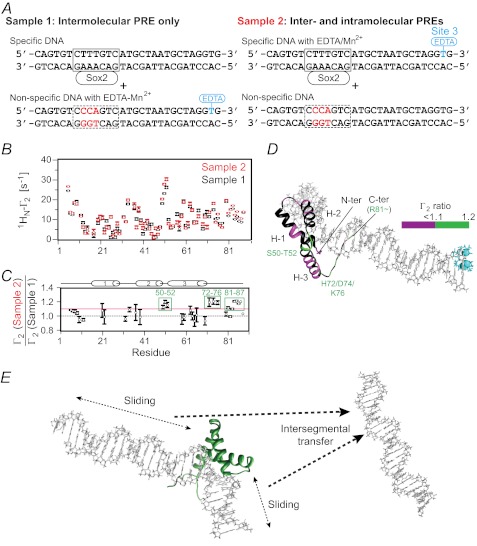FIGURE 6.
Intramolecular versus intermolecular translocation of Sox2 in the specific Sox2·Hoxb1-DNA binary complex. A, the samples comprise an equimixture of specific and nonspecific 29-bp DNA duplexes. In sample 1, the specific DNA duplex is unlabeled, and the nonspecific DNA duplex bears the paramagnetic label. In sample 2, the specific DNA duplex is paramagnetically labeled at site 3 (cf. Fig. 5A), and the nonspecific DNA duplex is unlabeled. The PRE effects observed for sample 1 arise entirely from intermolecular translocation, whereas those for sample 2 arise from both intra- and intermolecular translocation processes. The concentrations of Sox2, specific DNA, and nonspecific DNA are 0.40, 0.45, and 0.45 mm, respectively. B, PRE profiles at 150 mm NaCl from samples 1 and 2 shown as black and red circles, respectively (error bars, S.D.). C, ratio of PRE rates for sample 2 to sample 1 for residues with 1HN-Γ2 rates of >10 s−1. For Γ2(sample 2)/Γ2(sample 1) ∼ 1, the PRE effects arise predominantly from intermolecular translocation; Γ2(sample 2)/Γ2(sample 1) ratios larger than 1 are indicative of contributions from both intra- and intermolecular translocation, where the contribution from the latter is provided by the PRE profiles observed for sample 1. D, mapping of Γ2 ratios (color scale indicated on the right) onto the structure of the specific Sox2·DNA complex (23). E, schematic of intramolecular (sliding) and intermolecular (intersegment transfer) translocation events involving Sox2 bound specifically to DNA. Because bulk intersegment transfer of Sox2 between specific sites involves complete dissociation of Sox2 into free solution, followed by reassociation, the sparsely populated states arising from intermolecular translocation from the specific duplex to a nonspecific duplex and back again sampled by PRE must involve an initial sliding event from the specific site to an adjacent nonspecific site, followed by direct intersegment transfer to the nonspecific duplex and then back to the specific duplex.

